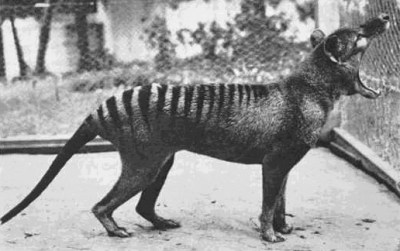
Scientists estimate that approximately 900 species have gone extinct in the last five centuries alone, to say nothing of the thousands or millions that vanished from life in the billions of years before that.
Conventional wisdom states that once an animal has gone extinct, it’s gone forever. However, a team from the University of Melbourne hopes to change all that, with their new project aiming to bring the Tasmanian Tiger back to life.
An Obscure Icon

The Tasmanian Tiger, or thylacine as it is also known, was last seen in 1936, when a male named Benjamin passed away in captivity in Hobart Zoo. In the wild, it’s suspected that the species first began nearing extinction in most of its habitat around 2,000 years ago, with human factors and changes in climate primarily cited as causal factors.
Wild examples of the carnivorous marsupial were last reported the Australian mainland in the 1830s. Habitat destruction, hunting, and disease finally conspired to wipe the thylacine from the wild on the island of Tasmania, with the last example killed by a farmer in 1930.
With its unique “long stripy dog” appearance, thylacines measured on the order of 180 cm long from nose to tail, and 58 cm high. Indeed, those stripes are what scored the animal the name “Tasmanian Tiger” even though it is in no way related to any kind of feline animal.
Sightings of thylacines are still reported now and then by eager enthusiasts, but none have ever been confirmed in the last 86 years of looking. Whether it’s the animal’s obscurity, it’s curious look, or simply the fact that people want what they can’t have, the thylacine continues to captivate the hearts and minds of wildlife enthusiasts in Australia and beyond.
A Candidate for De-Extinction

As loved as it is, there are other reasons that the thylacine is a prime candidate for de-extinction efforts. Thanks to a baby that was collected in the early 20th century, scientists were later able to sequence the animal’s full genome. It’s a significant achievement; having only a partial genome has frustrated many other de-extinction efforts like the work to bring back the woolly mammoth.
Armed with this data and with the benefit of a $5 million donation, the University of Melbourne is establishing a lab for the explicit purpose of resurrecting the Tasmanian tiger and pursuing de-extinction and marsupial conservation research. The lap will be known as the Thylacine Integrated Genetic Restoration Research Lab, or TIGRR for short.
The lab’s overarching goal will be to resurrect the thylacine, but it will also pursue research into stem cell technology, as well as gene editing and the use of surrogates in order to push forward the field of de-extinction. The hope is that the lab’s work may help prevent some marsupial species from falling victim to extinction in the way the Tasmanian tiger did.

Initial efforts will investigate the possibility of using marsupial stem cells to create a viable thylacine embryo. This embryo would then be transplanted into a surrogate mother. Prime candidates for surrogacy are the dunnart or the Tasmanian devil, considered close enough to the thylacine to make a pregnancy viable.
Being a marsupial species, the thylacine has several benefits going for it when it comes to pregnancy. Once an embryo has been created and transferred to the uterus of a surrogate species, it will undergo gestation. However, unlike mammals, marsupial species tend to a have much shorter and less complex, with the tiny young then transferring to the mother’s pouch for further development. This period of pouch life and suckling can readily be replaced with bottle feeding in the lab, further simplifying the early development of a young, newborn thylacine.
It all sounds simple on paper, and indeed, the team at the University of Melbourne have set a clear path forward for what they hope to achieve. However, it will take years of work to develop techniques in stem cell cultivation, embryo creation, and uteral implantation to actually get to the point of birthing a thylacine. Regardless, similar work has been done before in cloning non-extinct animals, so it’s not outside the realms of possibility.
Of course, cloning a thylacine from century-old genetic material is one thing, and establishing a thriving population is another. With only one genome to work with, a lack of genetic diversity could make starting a self-sustaining colony of thylacines difficult or impossible. There are few, if any, living marsupial relatives close enough to interbreed a thylacine with to kickstart a fresh population, sadly.
Regardless, the money is now there, and the scientists are on the job, so it could be a remarkably short period from now until we see the first thylacine born on Earth in a century.
0 Commentaires